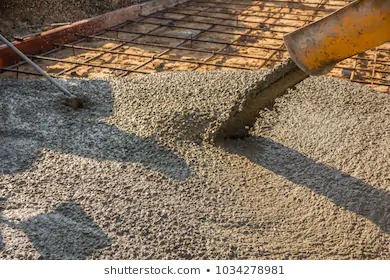Grade of Concrete and Water Cement Ratio
Grades of concrete and water cement ratio is very essential in mixing so that is why it gain a lot importance in civil engineering . The strength of concrete is depends upon mixing of water and cement in require quantity . There are various types of concrete for example M 5, M 7.5, M 10, M 15, M 20 etc. (M stands for mix and the number like 5 ,7.5 ,10 ,15 ,20 are characteristic comprehensive strength of concrete in 28 days) like after 28 days the strength will be 5 N/MM square .Now we presenting this in a chart.
Technical Terms
PCC
The abbreviation of Pcc is Plane cement concrete. It is compose of cement, sand and aggregates but are not use for load bearing structure like Rcc. It is like the paste which is use for the finishing of the floor and irregularities of wall to make a smooth surface. Moreover it also use under the column whose lies of bed of the Earth.
RCC
It is stand for the Reinforced Cement Concrete. The structure made of Rcc are reinforced with steel bars on the side of bending tension. This is done because concrete is basically weak in tension.
RBC
It is stand for the Reinforced Brick Concrete. It is the combination of all these three material ( reinforcement, bricks and concrete ).Bricks are only use as filling material which doesn't help to increase the strength of RCC. Concrete is not so good in tension and material below neutral axis dp not take part in load resisting, so that portion is replaced by using bricks.
DPC
It is stand of Damp Proof Course. It is a barrier through the structure designed to prevent moisture rising by capillary action, this phenomenon is known as rising damp. Rising damp is the effect of water rising from the ground in to the building or structure.This damp proof course may be horizontally or vertically. A dpc layer is usually laid below a;; masonry walls, regardless of the wall is a load bearing wall or a partition wall.RMC
It is stand for the ready mix concrete that is manufactured in a batching plant, according to a set recipe and then delivered to awork site by the different means of transportation like truck mounted in transit mixer.
Note : C is stand for Cement , S is stand for Sand and A stand for Aggregates .
 |
| https://daecivilinfo.blogspot.com/2020/05/grade-of-concrete-and-water-cement-ratio.html |
Grades of Cement Quantity of Water Mix Ratio
(Per Bag 50 kg)
C : S : A
M 5 60 liters 1:5:10
M 7.5 45 liters 1:4:8
M 10 34 liters 1:3:6
M 15 32 liters 1:2:4
M 20 30 liters 1:1.5:3
Densities of materials
PCC : ( No steel involved )
Pcc means plane cement concrete and it's density is 2400 kg/cubic meter
RCC : ( It includes steel )
Rcc means reinforcement cement concrete and it's density is 2300 to 2700 kg/cubic meter
Brick or Brick Masonry :
The density of brick is 1600 to 1900 kg/cubic meter
Concrete Block :
It's density is 2100 kg/cubic meter
Density of construction materials are its mass per unit volume of materials. It is expressed in kg/m3 or lb/ft3 and shows compactness of building material.Density is also called as unit weight of substance. It is represented by symbol called row (p). Density represents the degree of compactness of material. If the material is of more density, it is more compacted material.
p = m/v
Units = kg/m3 or lb/ft3
Conversion: 1 kg/m3 = 0.624 lb/ft3
PCC : ( No steel involved )
 |
| https://daecivilinfo.blogspot.com/2020/05/grade-of-concrete-and-water-cement-ratio.html |
RCC : ( It includes steel )
Rcc means reinforcement cement concrete and it's density is 2300 to 2700 kg/cubic meter
 |
| https://daecivilinfo.blogspot.com/2020/05/grade-of-concrete-and-water-cement-ratio.html |
Brick or Brick Masonry :
The density of brick is 1600 to 1900 kg/cubic meter
 |
| https://daecivilinfo.blogspot.com/2020/05/grade-of-concrete-and-water-cement-ratio.html |
Concrete Block :
It's density is 2100 kg/cubic meter
 |
| https://daecivilinfo.blogspot.com/2020/05/grade-of-concrete-and-water-cement-ratio.html |
Concrete Works in Extreme weather
During work no matter what kind of work it is weather effects it very badly but in construction or concrete work it deserves more impotence. Condition of weather directly effect the work ability or the strength of concrete.Necessity during work in extreme weather
- Unless adequate protection is provided and approval is obtained, concrete shall not be placed during rain.
- Rain shall not be allowed to increase the mixing water or to damage the finishing of surface.
- When the temperature of the surrounding air is expected to be below 5 degree during placing or within 24 hours thereafter, the temperature of the plastic concrete, as placed shall be no lower then 13 degree for sections less than 300 mm in any dimension or 10 degree for any other section.
- When necessary concrete material should be heated before mixing and carefully protected after placing, in general, heating or mixing water alone to about 60 degree may be sufficient for this purpose. Dependence should not be placed on salt or other chemical for the prevention of freezing. Calcium chloride up to 1- 0.5 percent of the weigh of cement may be used to accelerate the rate of hardening only with prior written permission of engineer.
- If the water or aggregate is heated above 38 degree the water shall be combined with the aggregate in the mixer before cement is added. Cement shall not be mixed with water or with mixtures of water and aggregate having s temperature greater than 38 degree.
- Other precautions recommended by ACI standard 305-72 shall be adopted.



1 Comments
This is amazing information about Concrete Work.
ReplyDeleteIf anyone have any queries let me know